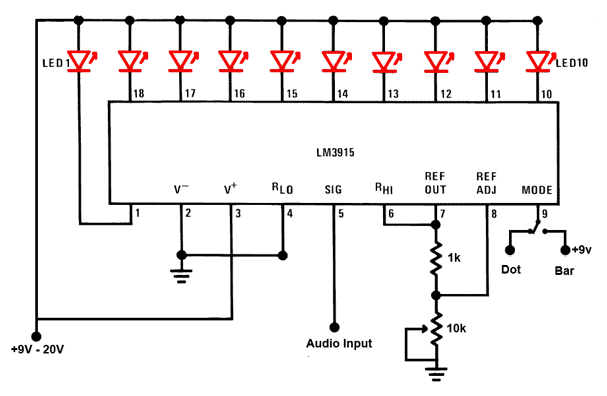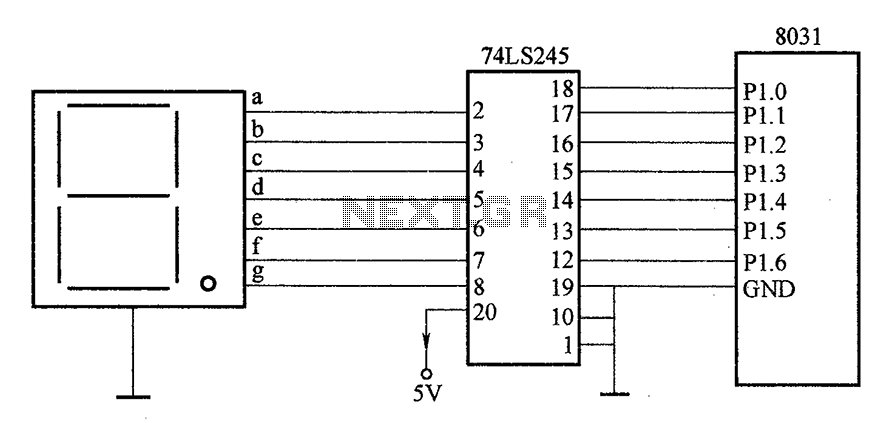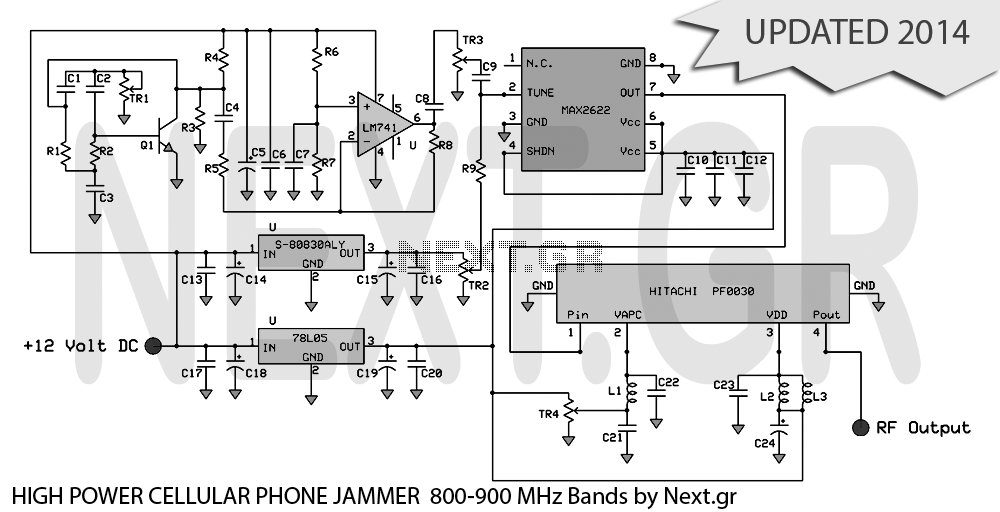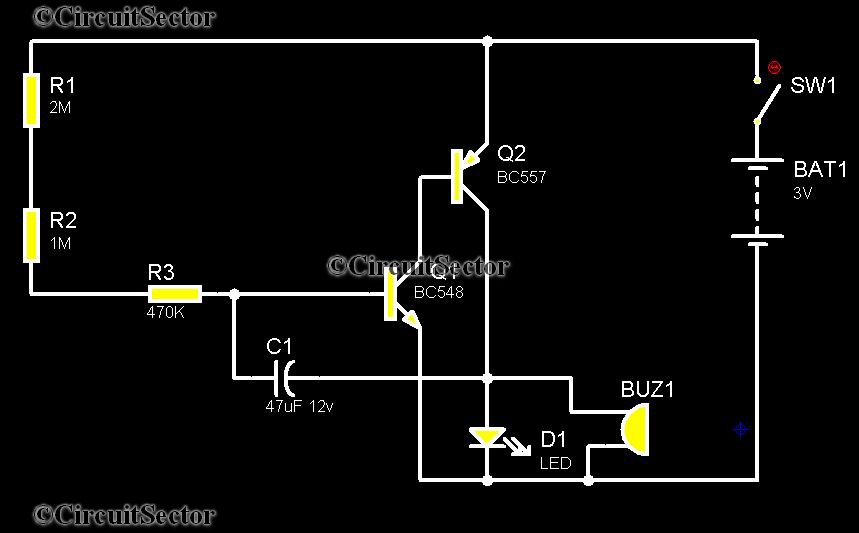
5V TOP414G 2A isolated switching power supply circuit
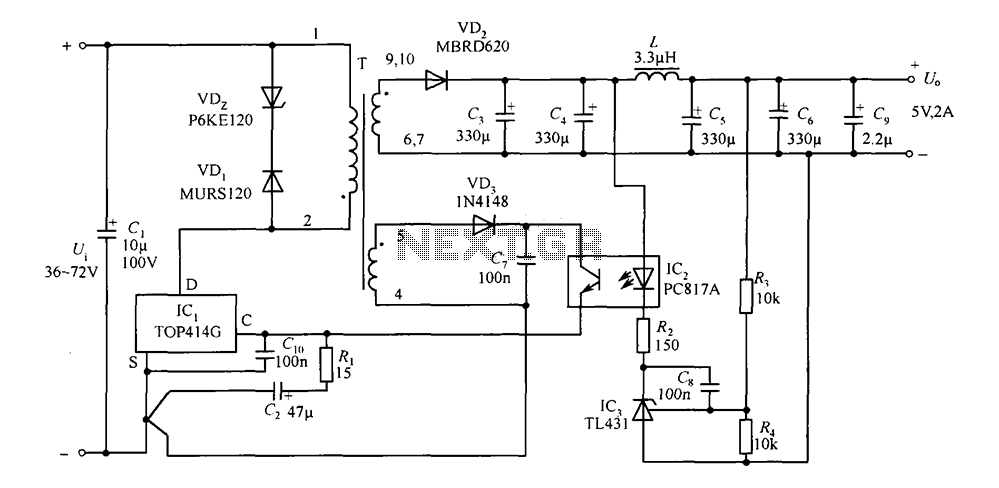
The circuit consists of a 5V TOP414G isolated switching power supply with a 2A output. C1 serves as the input filter capacitor. The circuit includes a voltage clamp protection mechanism composed of VD1. The control terminal is connected to a resistor R1, while C2 functions as a bypass capacitor. The TOP414GC-S is connected in parallel with C10 to mitigate high-frequency interference that may occasionally trigger circuit malfunctions. VD2 acts as the output rectifier diode, while the output filtering is managed by capacitors C3, C4, and inductors L, C5, and C6. C9 is utilized for noise cancellation at the output. An external error amplifier, formed by a TL431 shunt regulator, monitors the output voltage. When fluctuations occur, resistors R3 and R4 create a voltage divider to sample the output voltage, which the TL431 compares against a reference voltage. This results in an external control signal that modifies the current through the control terminal of the TOP414G via the optocoupler PC817A, thereby stabilizing the output voltage (Uo). The control loop gain is determined by resistor R2. The feedback winding voltage is rectified by VD3 and capacitor C7 to supply power to the infrared receiver of the PC817A.
The described circuit is a robust solution for generating a stable 5V output from an isolated switching power supply. The use of the TOP414G provides efficient power conversion with a maximum output current of 2A, making it suitable for various applications requiring stable voltage regulation. The input filter capacitor, C1, is essential for reducing voltage spikes and noise from the power supply, ensuring that the circuit operates reliably.
The voltage clamp protection provided by VD1 is critical for safeguarding the circuit against over-voltage conditions, which could potentially damage sensitive components. The combination of R1 and C2 at the control terminal serves to stabilize the control loop and improve transient response by filtering out high-frequency noise.
The parallel connection of TOP414GC-S with C10 is a strategic design choice aimed at enhancing the overall stability of the switching power supply. It helps prevent high-frequency interference from affecting the operation of the control circuit, thereby reducing the likelihood of unwanted power outages.
The output stage of the circuit, which includes VD2, C3, C4, L, C5, and C6, is designed to ensure that the output voltage remains within specified limits while minimizing ripple and noise. C9 plays a vital role in noise cancellation, further enhancing the quality of the output voltage.
The TL431 shunt regulator is an effective choice for providing feedback control in this application. It allows for precise regulation of the output voltage by comparing the sampled voltage from R3 and R4 against its internal reference voltage. The resulting control signal adjusts the duty cycle of the TOP414G, maintaining a stable output voltage despite variations in load or input voltage.
The feedback winding voltage, rectified by VD3 and C7, powers the infrared receiver of the PC817A, ensuring that the optocoupler operates effectively. This isolation between the control and output stages is crucial for protecting sensitive components from potential faults in the output circuit.
Overall, this circuit design demonstrates a well-thought-out approach to creating a reliable and efficient isolated switching power supply, suitable for a variety of electronic applications requiring 5V power.Constituted by a 5V TOP414G, 2A output isolated switching power supply circuit is shown. C1 is the input filter capacitor. VDz VD1 composition and primary clamp protection circ uit. The control terminal of the resistor R1, C2 is a bypass capacitor. TOP414GC-S parallel between the end of the C10 is to prevent high-frequency interference appears on the control side sometimes cause power outages trigger circuit malfunction. VD2 output rectifier diode, output filter C3, C4, L, C5 and C6 constituted, C9 as an output capacitor noise cancellation.
External error amplifier by a TL431 shunt regulator composition. When the output voltage fluctuates, by R3, R4 after the voltage obtained by dividing the sample voltage, the TL431 with a reference voltage, and generates an external control signal, and then to change TOP414G control terminal current through optocoupler PC817A, thereby regulating the duty than make Uo stabilize. Control loop gain is set by R2. After the feedback winding voltage VD3, after C7 rectifier to PC817A the infrared receiver power supply.
The described circuit is a robust solution for generating a stable 5V output from an isolated switching power supply. The use of the TOP414G provides efficient power conversion with a maximum output current of 2A, making it suitable for various applications requiring stable voltage regulation. The input filter capacitor, C1, is essential for reducing voltage spikes and noise from the power supply, ensuring that the circuit operates reliably.
The voltage clamp protection provided by VD1 is critical for safeguarding the circuit against over-voltage conditions, which could potentially damage sensitive components. The combination of R1 and C2 at the control terminal serves to stabilize the control loop and improve transient response by filtering out high-frequency noise.
The parallel connection of TOP414GC-S with C10 is a strategic design choice aimed at enhancing the overall stability of the switching power supply. It helps prevent high-frequency interference from affecting the operation of the control circuit, thereby reducing the likelihood of unwanted power outages.
The output stage of the circuit, which includes VD2, C3, C4, L, C5, and C6, is designed to ensure that the output voltage remains within specified limits while minimizing ripple and noise. C9 plays a vital role in noise cancellation, further enhancing the quality of the output voltage.
The TL431 shunt regulator is an effective choice for providing feedback control in this application. It allows for precise regulation of the output voltage by comparing the sampled voltage from R3 and R4 against its internal reference voltage. The resulting control signal adjusts the duty cycle of the TOP414G, maintaining a stable output voltage despite variations in load or input voltage.
The feedback winding voltage, rectified by VD3 and C7, powers the infrared receiver of the PC817A, ensuring that the optocoupler operates effectively. This isolation between the control and output stages is crucial for protecting sensitive components from potential faults in the output circuit.
Overall, this circuit design demonstrates a well-thought-out approach to creating a reliable and efficient isolated switching power supply, suitable for a variety of electronic applications requiring 5V power.Constituted by a 5V TOP414G, 2A output isolated switching power supply circuit is shown. C1 is the input filter capacitor. VDz VD1 composition and primary clamp protection circ uit. The control terminal of the resistor R1, C2 is a bypass capacitor. TOP414GC-S parallel between the end of the C10 is to prevent high-frequency interference appears on the control side sometimes cause power outages trigger circuit malfunction. VD2 output rectifier diode, output filter C3, C4, L, C5 and C6 constituted, C9 as an output capacitor noise cancellation.
External error amplifier by a TL431 shunt regulator composition. When the output voltage fluctuates, by R3, R4 after the voltage obtained by dividing the sample voltage, the TL431 with a reference voltage, and generates an external control signal, and then to change TOP414G control terminal current through optocoupler PC817A, thereby regulating the duty than make Uo stabilize. Control loop gain is set by R2. After the feedback winding voltage VD3, after C7 rectifier to PC817A the infrared receiver power supply.
